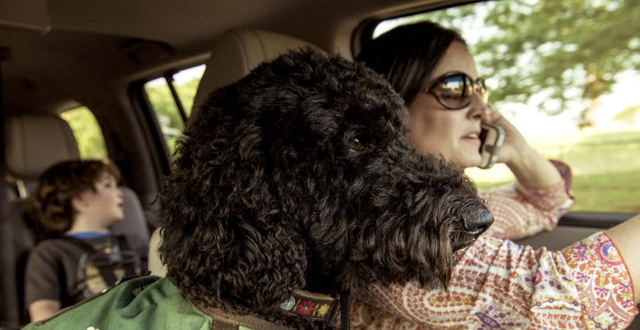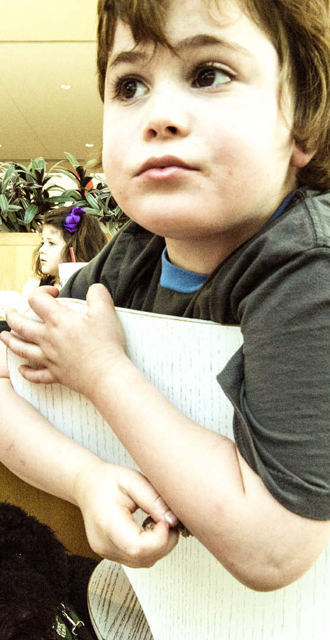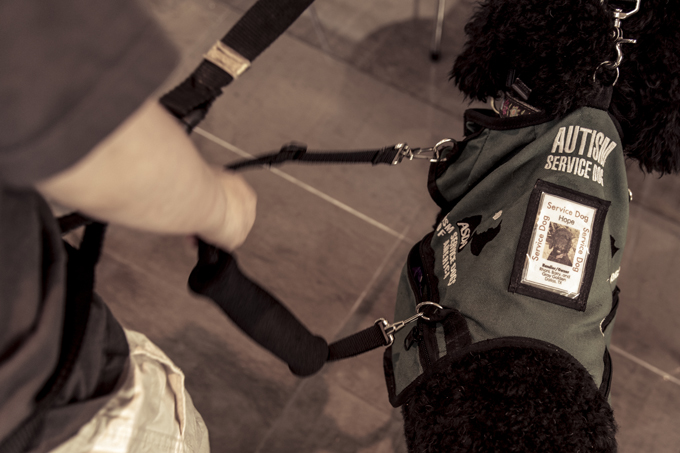We are in print!
One of my favorite local magazines decided to do a story about Hope and Gray for their September issue. Today is a VERY exciting day.
Rhoni Golden and her three children claim a table at NorthPark Center’s food court to dine on Sonic. Nine-year-old Zoe and 4-year-old Lena sip blue slushies with their meals, while 7-year-old Gray sticks to his usual — a hamburger and fries.
It’s a commonplace scene, except for the black labradoodle lying calmly under the table. Dogs are not allowed at NorthPark, unless they are service dogs.
Hope is Gray’s “anchor” when the Goldens go out. Photo by Danny FulgencioHope is the labradoodle’s name, and she is tethered to Gray. Golden wouldn’t brave this seemingly mundane trip to Sonic without the dog, “considering how autistic my son is.”
“My husband says I should emphasize the words ‘mentally handicapped’ — severely,” Golden says. “My son does not speak, is not completely potty trained and just this morning, I had to clean poop off the walls of his room.”
Life is anything but mundane for the Golden family, who live in Lakewood Hills. Rhoni Golden and her husband, Barry, learned their second child had autism when he was 19 months old. A physical therapist herself, Golden immediately placed him in therapy, believing that it would “fix” Gray enough to ready him for a mainstream kindergarten classroom.
By the time Gray was 4, and still not talking, Golden’s dreams of a “normal” life for her son were shattered.
As long as Gray could be strapped into a stroller, the Goldens could go to the park or out to dinner without too much disturbance. That ended around the time he turned 5.
“We rarely go anywhere as a complete family. It’s just pretty much impossible,” Golden said earlier this year. “I’ve been with Gray at the park when he’s run out of the park and sat down in front of a moving car. Once I checked email for a couple of minutes, then ran through the house screaming his name to find out he’d run outside and was playing in the sprinkler naked.”
Then Hope entered their lives.
The family didn’t name the dog, and when Golden first learned her name, she found it a little sappy. But Hope has lived up to her moniker.
Autism service dogs are a fairly new innovation. The organization that trained Hope, Autism Service Dogs of America (ASDA), was founded in 2002 and was the first to specialize in training dogs for people with autism, says Kati Wolfe, ASDA’s placement training director and autism specialist, as well as Hope’s trainer.
A “Today” show episode introduced the Goldens to autism service dogs last fall, and by February, Rhoni Golden was on a plane to Portland, where she spent a few days of intensive training with Hope before bringing her home to Dallas.
Hope is only the second autism service dog in Texas; one other resides in Austin, Golden says. The labradoodle was an $18,000-plus investment, one that Golden is so grateful her family could afford because she believes Hope is worth every penny.
Where Gray Golden, a 7-year-old boy with severe autism, goes, so does his service dog, Hope. Photo by Danny FulgencioPerhaps the hardest consequence of autism is loneliness, not only because few others understand the situation but also because of the self-induced confinement.
“People tell me they don’t see many other kids like Gray, and I say, ‘Well, they don’t go out,’ ” Golden says. “I think a lot of people feel sort of shamed.”
Gray, especially when he is in unfamiliar settings, can become overwhelmed by sounds, noises and crowds, “which causes him to go into tantrums, to throw himself to the ground, and he might lash out at others,” Wolfe says.
“Children with autism are losing everyday skills of how to access their community, how to go into a restaurant and be quiet, because they are isolated,” Wolfe says, “and when you isolate, you build fear.”
Hope changes this dynamic. On the trip to Sonic, Golden attaches Gray’s belt to the service pack on Hope’s back as soon as they step out of the car.
“She’s an anchor for him,” Golden says, with four feet of tether acting as Gray’s boundaries. He approaches the mall holding a handle on Hope’s pack, as he has been taught, and maintains this stance most of the time. If Gray starts to unravel, Hope stands firm, and Golden, who holds the dog’s leash, feels the tugging and quickly reacts to steady her son.
“Without Hope here right now, Gray would probably be running around stealing fries off people’s plates, or running down the escalator with me shoving people out of the way trying to get to him,” she says.
Hope has changed the lives of Zoe and Lena just as drastically. Between tater tots, Zoe exclaims her excitement that her family can now go to movies together or pull in to TCBY on a whim, she says, and even vacation together.
“I want to have some time with my family — not just mom or just dad,” Zoe says. “We can go out with Gray now because of Hope.”
It has cost Zoe to have a brother like Gray. Until Hope, she was limited on what she could do socially by whether her family could find a babysitter (not an easy task with an autistic child) and invitations from friends, “and you can’t just say, ‘Hey, invite me over,’ ” Zoe says. Despite this, she views herself as her brother’s protector and caretaker, and ardently defends him.
“Other people think of him as horrible and bad. They don’t understand him,” Zoe says. “Some autistic children, they can’t love. Gray, I know he loves me.”
She mimics the way he tells her this — “I uh yooou.” She also knows by the way he tackles her, one of Gray’s forms of hugging. It pains Zoe that she can talk to Gray only through an iPad with a special app that turns it into a speaking device. The app allows Gray to communicate about things like what he wants to eat.
“He has a nice voice on his iPad, but I want to hear his voice,” Zoe says. “What I’ve taught my little sister is, ‘You and me are Gray’s sisters, and we take good care of him, and we will make him talk.’ ”
“Me and Zoe will help Gray,” Lena echoes.
And now that Hope is part of the family, she is Gray’s protector, too, Zoe says.
“She’s holding him, she’s taking care of him,” his big sister observes. “She wouldn’t let him run down the aisles and scream and pull people’s hair and hurt people.”
When Gray is untethered at home, he sometimes goes to Hope to pet her, and makes cooing noises, Zoe says. “I can tell he loves Hope,” she says.
The whole family has fallen head over heels for the labradoodle. Golden emphasizes that Hope is not a pet, but sometimes has to remind her children. On the walk to Sonic, Lena affectionately throws her arms around Hope and her mother chastises, “Lena, no, she’s working.”
Hope seems unfazed, however, and Gray continues calmly walking beside her.
“He stops and looks around a whole lot more,” Golden says. “Before the dog, he was so focused on moving, going, getting to the next destination. He didn’t focus on his environment at all.”
It would be easier for the Golden family to do what many families with a severely autistic child do — hole up at home, and deal with the challenges privately rather than having to deal with the frustrations and embarrassments that inevitably happen in public. But that was never an option.
Golden describes herself as an “open book — it doesn’t occur to me to hide anything.” When she realized the extent of Gray’s autism years ago, she quit her job as a physical therapist to focus on her family. But when she was helping patients, “my attitude to them was always, ‘Live your life. Go make the best of it.’ ”
She has adopted the same mantra for herself and her family, and for the most part, “everybody is rooting for us. Everybody wants to hear the happy ending about the disabled kid who gets to go out and live a normal life,” Golden says. On a few occasions, however, the Goldens have had to defend Hope’s right to be in public places.
Gray is a first-grader this year, and because of Hope, the Goldens felt confident enough to move him from Oak Hill Academy to Dallas ISD’s John F. Kennedy Learning Center near Ross and Henderson. When they tried to enroll Gray, DISD’s legal department fought them, saying the district could not provide a handler for Hope. The district thought an aide for Gray would be enough, Golden says, but she insisted otherwise.
“Wherever my son goes, the dog goes,” Golden says. “With autism, it’s gotta be consistent. It’s all or nothing.”
The Goldens were backed up by a precedent of successful federal suits involving autism service dogs, as well as by the principal and teachers at JFK, Golden says. The district eventually agreed that Gray’s aide also could be Hope’s handler.
So on May 30, Hope became the first service dog to attend a DISD school.
The Goldens know new challenges will arise as Gray grows older and bigger. One of the worst characteristics of autism is the tendency to assault strangers, Golden says, and “teenage assaults are worse than little kid assaults.”
She tends to live in the present, however, taking one day at a time. Thanks to Hope, the living is easier these days — most importantly for Gray, Golden says.
“I don’t know what life holds for him in the future,” she says, “but right now, while he’s living under my roof, I’m going to make sure he has the best life possible.”
To read about the Golden family’s challenges and victories with Hope at their side, visit hopeforgray.com. While there, click on “donate” in the navigation bar to make a contribution the “Hope for Gray” fund started by the Goldens to increase the number of children who can benefit from a dog like Hope.
– See more at: http://lakewood.advocatemag.com/2013/08/27/first-dallas-isd-service-dog-aids-lakewood-familys-autistic-child/




awesome article! loved the pic of Hope in the car. She would do the same when we had her too. So glad she is making such a difference.
Awesome!!! What a wonderful story!!